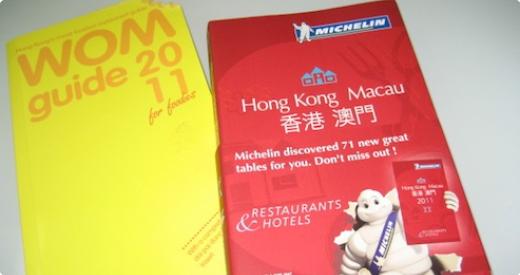
As the year ends,food writers’ calendars are filled with the launch of many restaurant guides. This December, the Michelin guide, WOM and Tatler’s Best Restaurant Guide all recently launched their 2011 guides.
For more than a century now, the Michelin guides have helped travellers enjoy their trips with restaurant and hotel recommendations in Europe. The star rating of the Michelin guide is held with high respect. It became a chef’s ultimate dream to be bestowed three stars. Sadly, getting a lower star ranking has pushed some European chefs to commit suicide in the past.
Here in Asia, Michelin just launched its third edition of the bilingual Hong Kong Macau guide (with guides available for Tokyo Yokoham and Kamakura, Kyoto, Osaka, and Kobe as well). Thirteen newly selected restaurants in Hong Kong were awarded stars, giving them prestigious bragging rights. The guide has a stronger emphasis on appreciating the local eateries. There’s the new 3-starred Cantonese restaurant, Sun Tong Lok known for its stuffed crab shell and roast suckling pig. But what the guide prides itself is in featuring 55 simple shop restaurants in Hong Kong and Macau serving local food. One star establishments like Ho Hung Kee for its shrimp wanton, Hung’s Delicacies for its marinated pork belly or braised veggies in red tofu sauce, or the long queue at One Dimsum for its steamed prawn dumpling or barbecue pork buns, prove that Hong Kong is a city where diners can enjoy gourmet meals for as low as HK$16.
While Michelin employs internationally trained, anonymous, local inspectors who repeatedly visit the restaurant (even as many as eight times), WOM takes another path. It prides itself for its “honest, fun, and witty” reviews created by 15,000 Hong Kongers who share their dining experiences on the online site. It clearly establishes itself as an authentic local guide. Taking it even further this year, it included a special pull-out guide on Hong Kong’s Real Dai Pai Dongs. As no new licenses have been issued since the 1970’s, this simple street side dining stalls is a dying culinary heritage. Twenty-eight of these Dai Pai Dongs scattered across the city are aptly featured, highlighting their signature dishes.
The descriptors in the WOM guide are pulled from actual quotes of its online reviewers. But like the comments on Tripadvisor or other travel sites, I take it with a grain of salt, wondering if I seek the same travel or in this case dining experience as this reviewer. What I appreciate most about the WOM guide are the lists they provide. In a city filled with a plethora of options for restaurants, having a list for a great brunch place, a place to bring out-of-towners, kids and dog friendly places, and even where to impress the in-laws is a great help. It narrows down the choices. For wine lovers, WOM’s BYOB list where you can see which restaurants charge $0, less than $100 or more than $100 for corkage comes really handy.
While chefs covet the stars and restaurateurs appreciate the marketing pull of being mentioned in a restaurant guide, ultimately, it is the readers who benefit the most from the publication of these guides. Having access to information enables them to make informed choices on where to eat. But in making that decision, it is wise to remember that these reviews are not gospel truth. They are merely recommendations. And as in seeking any advice in life be it a good haircut from a hairdresser or medical advice from a doctor…it boils down to one question: Who do you trust?
Text and Photo by Maida Pineda. Posted 14 December 2010









